Sut i ddiffinio ystod yn seiliedig ar werth cell arall yn Excel?
Mae cyfrifo ystod o werthoedd yn hawdd i'r mwyafrif o ddefnyddwyr Excel, ond a ydych erioed wedi ceisio cyfrifo ystod o werthoedd yn seiliedig ar y nifer mewn cell benodol? Er enghraifft, mae colofn o werthoedd yng ngholofn A, ac rwyf am gyfrifo nifer y gwerthoedd yng ngholofn A yn seiliedig ar y gwerth yn B2, sy'n golygu, os yw'n 4 yn B2, y byddaf yn cyfartaleddu'r 4 gwerth cyntaf yn colofn A fel y dangosir isod. Nawr rwy'n cyflwyno fformiwla syml i ddiffinio ystod yn gyflym yn seiliedig ar werth cell arall yn Excel.
Diffinio ystod yn seiliedig ar werth celloedd
 Diffinio ystod yn seiliedig ar werth celloedd
Diffinio ystod yn seiliedig ar werth celloedd
I gyfrifo am ystod yn seiliedig ar werth cell arall, gallwch ddefnyddio fformiwla syml.
Dewiswch gell wag y byddwch chi'n ei rhoi allan o'r canlyniad, nodwch y fformiwla hon = CYFARTAL (A1: INDIRECT (CONCATENATE ("A", B2))), a'r wasg Rhowch allwedd i gael y canlyniad.
1. Yn y fformiwla, A1 yw'r gell gyntaf yn y golofn rydych chi am ei chyfrifo, A yw'r golofn rydych chi'n cyfrif amdani, B2 yw'r gell rydych chi'n ei chyfrifo yn seiliedig arni. Gallwch chi newid y cyfeiriadau hyn yn ôl yr angen.
2. Os ydych chi am wneud crynodeb, gallwch ddefnyddio'r fformiwla hon = SUM (A1: INDIRECT (CONCATENATE ("A", B2))).
3. Os nad yw'r data cyntaf yr ydych am ei ddiffinio yn rhes gyntaf yn yr Excel, er enghraifft, yng nghell A2, gallwch ddefnyddio'r fformiwla fel hyn: = CYFARTAL (A2: INDIRECT (CONCATENATE ("A", ROW (A2) + B2-1))).
Cyfrif / Swmio celloedd yn gyflym yn ôl cefndir neu liw fformat yn Excel |
| Mewn rhai achosion, efallai bod gennych chi ystod o gelloedd â lliwiau lluosog, a'r hyn rydych chi ei eisiau yw cyfrif / swm gwerthoedd yn seiliedig ar yr un lliw, sut allwch chi gyfrifo'n gyflym? Gyda Kutools ar gyfer Excel's Cyfrif yn ôl Lliw, gallwch chi wneud llawer o gyfrifiadau yn gyflym yn ôl lliw, a hefyd gallwch gynhyrchu adroddiad o'r canlyniad a gyfrifwyd. Cliciwch i gael treial llawn am ddim mewn 30 diwrnod! |
 |
| Kutools ar gyfer Excel: gyda mwy na 300 o ychwanegion Excel defnyddiol, am ddim i geisio heb unrhyw gyfyngiad mewn 30 diwrnod. |
Offer Cynhyrchiant Swyddfa Gorau
Supercharge Eich Sgiliau Excel gyda Kutools ar gyfer Excel, a Phrofiad Effeithlonrwydd Fel Erioed Erioed. Kutools ar gyfer Excel Yn Cynnig Dros 300 o Nodweddion Uwch i Hybu Cynhyrchiant ac Arbed Amser. Cliciwch Yma i Gael Y Nodwedd Sydd Ei Angen Y Mwyaf...

Mae Office Tab yn dod â rhyngwyneb Tabbed i Office, ac yn Gwneud Eich Gwaith yn Haws o lawer
- Galluogi golygu a darllen tabbed yn Word, Excel, PowerPoint, Cyhoeddwr, Mynediad, Visio a Phrosiect.
- Agor a chreu dogfennau lluosog mewn tabiau newydd o'r un ffenestr, yn hytrach nag mewn ffenestri newydd.
- Yn cynyddu eich cynhyrchiant 50%, ac yn lleihau cannoedd o gliciau llygoden i chi bob dydd!
